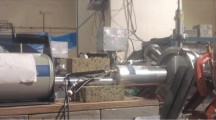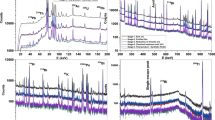Abstract
Lithium titanate and lithium aluminate, proposed as tritium breeding blanket materials in D–T fusion reactor, were analyzed by nuclear analytical techniques as a part of chemical quality control exercise. Concentrations of Li, Ti and Al were quantified by particle induced gamma-ray emission using 4 MeV proton beam from folded tandem ion accelerator facility. Trace elemental concentrations belonging to long-lived nuclides were determined by instrumental neutron activation analysis using neutron flux from Dhruva research reactor at BARC. The analysis results are useful in designing a shielded facility for tritium release studies of these irradiated breeder materials.



Similar content being viewed by others
References
Tillack M, Sharafat S, Youssef M, Herring S, Malang S, Sze DK (1994) Fusion nuclear technology and materials: status and R&D needs. Fusion Eng Des 25:21–34
Johnson CE, Hollenberg GW, Roux N, Watanabe H (1989) Current experimental activities for solid breeder development. Fusion Eng Des 8:145–153
Abdou MA, Wittenberg LJ, Maynard CW (1975) A fusion design study of nonmobile blankets with low lithium and tritium inventories. Nucl Technol 26:400–419
Sahu BS (2010) M. Tech. thesis Development of lithium titanate ceramic for the test blanket module (TBM) in fusion reactor. National Institute of Technology, Rourkela
Chhillar S, Acharya R, VittalRao TV, Bamankar YR, Mukerjee SK, Pujari PK, Aggarwal SK (2013) Non-destructive compositional analysis of sol–gel synthesized lithium titanate (Li2TiO3) by particle induced gamma-ray emission and instrumental neutron activation analysis. J Radioanal Nucl Chem 298:1597–1603
Miller JM, Hamilton HB, Sullivan JD (1994) Testing of lithium titanate as an alternate blanket material. J Nucl Mater 212–215:877–880
Mandal D, Shenoi MRK, Ghosh SK (2010) Synthesis & fabrication of lithium-titanate pebbles for ITER breeding blanket by solid state reaction and spherodization. Fusion Eng Des 85:819–823
Johnson CE (1991) Research and development status of ceramic breeder materials. J Nucl Mater 179–181:42–46
Segebade C, Weise H P, Lutz G J, Adams F (1988) Photon activation analysis. Anal Chim Acta 211: 339
Segebade C, Berger A (2008) Photon activation analysis. Encycl Anal Chem. doi:10.1002/9780470027318.a6211.pub2
Starovoitova V, Segebade C (2016) High intensity photon sources for activation analysis. J Radioanal Nucl Chem. doi:10.1007/s10967-016-4899-x
Segebade C, Starovoitova V, Borgwardt T, Wells DP (2017) Principles, methodologies, and applications of photon activation analysis: a review. J Radioanal Nucl Chem. doi:10.1007/s10967-017-5238-6
Raisanen J (2009) Particle-induced gamma emission (PIGE). In: Wang Y, Nastasi M (eds) Handbook of modern ion beam materials analysis. Materials Research Society, Warrendale, Pennsylvania
Chhillar S, Acharya R, Pai RV, Sodaye S, Mukerjee SK, Pujari PK (2012) A simple and sensitive particle induced gamma-ray emission method for non-destructive quantification of lithium in lithium doped Nd2Ti2O7 ceramic sample. J Radioanal Nucl Chem 293:437–441
Savidou A, Aslanoglou X, Paradellis T, Pilakouta M (1999) Proton induced thick target gamma-ray yields of light nuclei at the energy region Ep = 1.0–4.2 MeV. Nucl Instrum Methods B152:12–18
Mateus R, Jesus AP, Braizinha B, Cruz J, Pinto JV, Riberio JP (2002) Proton-induced gamma-ray analysis of lithium in thick samples. Nucl Instrum Methods B190:117–121
Chhillar S, Acharya R, Sodaye S, Sudarshan K, Santra S, Mishra RK, Kaushik CP, Choudhury RK, Pujari PK (2012) Application of particle induced gamma-ray emission for non-destructive determination of fluorine in barium borosilicate glass samples. J Radioanal Nucl Chem 294:115–119
Kiss ÁZ, Koltay E, Nyakó B, Somorjai E, Antilla A, Raisaien JJ (1985) Measurements of relative thick target yields for PIGE analysis on light elements in the proton energy interval 2.4–4.2 MeV. J Radioanal Nucl Chem 89:123–141
Smit Z, Tartari F, Stamati F, Vevecka A, Priftaj Istenic J (2013) Analysis of roman glass from Albania by PIXE–PIGE method. Nucl Instrum Methods B296:7–13
Karamanis DT, Aslanoglou XA, Assimakopoulos PA, Gangas NH (1999) Characterization of an aluminum pillared montmorillonite with cation exchange properties. J Radioanal Nucl Chem 242:3–9
Volfinger M, Robert J-L (1994) Particle-induced-gamma-ray-emission spectrometry applied to the determination of light elements in individual grains of granite minerals. J Radioanal Nucl Chem 185:273–29119
Hávranek V, Kučera J, Řanda Z, Voseček V (2004) Comparison of fluorine determination in biological and environmental samples by NAA, PAA and PIXE. J Radioanal Nucl Chem 259:325–329
Samudralwar DL, Robertson LD (1993) Determination of major and trace elements in bones by simultaneous PIXE/PIGE analysis. J Radioanal Nucl Chem 169:259–267
Weicheng Z, Tianmei Z, Xiangguo L (1991) Determination of 13C in breath sample by PIGE. J Radioanal Nucl Chem 151:313–317
Habrioux A, Surblé S, Berger P, Khodja H, D′Affroux A, Mailley S, Gutel T, Patoux S (2012) Nuclear microanalysis of lithium dispersion in LiFePO4 based cathode materials for Li-ion batteries. Nucl Instrum Methods B290:13–18
Mima K, Gonzalez-Arrabal R, Azuma H, Yamazaki A, Okuda C, Ukyo Y, Sawada H, Fujita K, Kato Y, Perlado JM, Nakai S (2012) Li distribution characterization in Li-ion batteries positive electrodes containing LixNi0.8Co0.15Al0.05O2 secondary particles (0.75 ≤ x ≤ 1.0). Nucl Instrum Methods B290:79–84
Mateus R, Jesus AP, Fonseca M, Luis H, Ribeiro JP (2007) The sensitivity of the PIGE analytical technique. Nucl Instrum Methods B264:340–344
Chhillar S, Acharya R, Tripathi R, Sodaye S, Sudarshan K, Rout PC, Mukerjee SK, Pujari PK (2015) Compositional characterization of lithium titanate ceramic samples by determining Li, Ti and O concentrations simultaneously using PIGE at 8 MeV proton beam. J Radioanal Nucl Chem 305:463–467
Chhillar S, Acharya R, Sodaye S, Pujari PK (2014) Development of particle induced gamma-ray emission methods for nondestructive determination of isotopic composition of boron and its total concentration in natural and enriched samples. Anal Chem 86:11167–11173
Chhillar S, Acharya R, Sodaye S, Sudarshan K, Santra S, Mishra RK, Kaushik CP, Choudhury RK, Pujari PK (2012) Application of particle induced gamma ray emission for non-destructive determination of fluorine in barium borosilicate glass samples. J Radioanal Nucl Chem 294:115–119
Chhillar S, Acharya R, Mishra RK, Kaushik CP, Pujari PK (2017) Simultaneous determination of low Z elements in barium borosilicate glass samples by in situ current normalized particle induced gamma-ray emission methods. J Radioanal Nucl Chem 312:567–576
Dasari KB, Chhillar S, Acharya R, Ray DK, Behera A, Lakshmana Das N, Pujari PK (2014) Simultaneous determination of Si, Al and Na concentrations by particle induced gamma-ray emission and applications to reference materials and ceramic archaeological artifacts. Nucl Instrum Methods B 339:37–41
Shinde AD, Acharya R, Reddy AVR (2017) Analysis of zirconium and nickel based alloys and zirconium oxides by relative and internal mono standard neutron activation analysis methods. Nuclear Eng Technol 49:562–568
Shinde AD, Acharya R, Reddy AVR (2014) Trace element determination in high-purity aluminum clad samples by k 0-based internal monostandard instrumental neutron activation analysis. J Radioanal Nucl Chem 299:1287–1292
Dasari KB, Acharya R, Lakshmana Das N (2013) Application of INAA to ancient bricks for grouping study using trace elements. J Radioanal Nucl Chem 298:699–705
Dasari KB, Acharya R, Lakshmana Das N, Reddy AVR (2012) A standardless approach of INAA for grouping study of ancient potteries. J Radioanal Nucl Chem 294:429–434
Shinde AD, Acharya R, Verma R, Reddy AVR (2012) Chemical characterization of graphite by instrumental neutron activation analysis. J Radioanal Nucl Chem 294:409–412
DeCorte F, Simonits A (1989) k 0-Measurements and related nuclear data compilation for (n, γ) reactor neutron activation analysis IIIb: tabulation. J Radioanal Nucl Chem 133:43–130
De Corte F, Simonits A (2003) Recommended nuclear data for use in the k0 standardization of neutron activation analysis. At Data Nucl Data Tables 85:47–67
Acknowledgements
Authors are thankful to the operating crew members of FOTIA, IADD and Dhruva reactor, BARC for their help during experiments. Authors thank Dr. N. K. Shukla, Head, Products Development Section and Dr. B. S. Tomar, Director, Radiochemistry Isotope Group, BARC for their support and encouragements. One of the authors (KBM) thanks HBNI, DAE, India for pursuing this work as a part of his PhD thesis work.
Author information
Authors and Affiliations
Corresponding author
Rights and permissions
About this article
Cite this article
Modi, K.B., Acharya, R., Munot, S. et al. Chemical characterization of lithium titanate and lithium aluminate as tritium breeders of fusion reactor by PIGE and INAA methods. J Radioanal Nucl Chem 314, 1113–1120 (2017). https://doi.org/10.1007/s10967-017-5457-x
Received:
Published:
Issue Date:
DOI: https://doi.org/10.1007/s10967-017-5457-x




